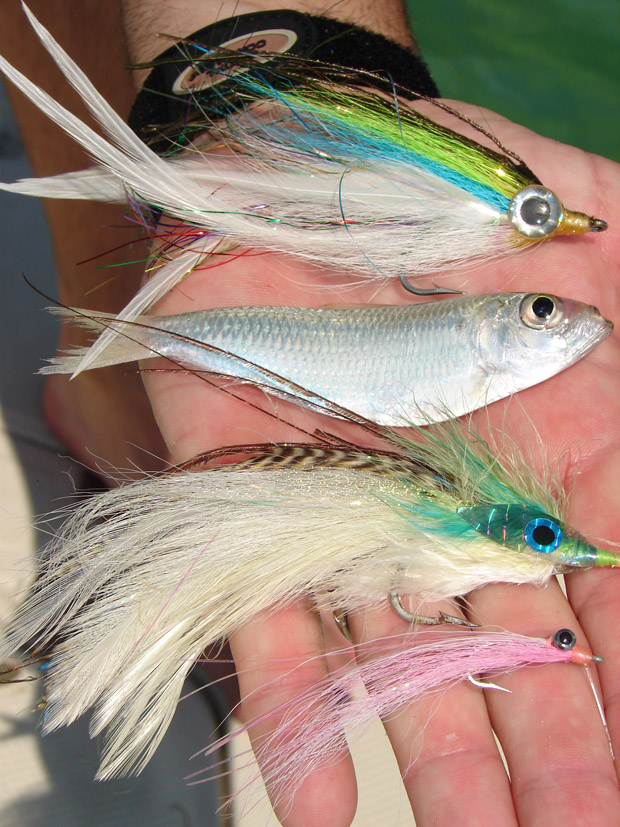October 08, 2014
By Will Geraghty
Mixed-bag action during the spring migration
 Sardine "chummer" and Deceiver variants. At bottom is Clouser Deep Minnow, a mackerel favorite.
Sardine "chummer" and Deceiver variants. At bottom is Clouser Deep Minnow, a mackerel favorite.
Wreck fly fishing is fun and rewarding, but purists will need to check their mindset at the dock. For dependable action, chumming is key. Frozen block chum and freshly cast-netted baitfish really get the snappers, jacks and mackerels prowling the upper portion of the water column.
Start by saturating the area with chum to generate a feeding frenzy. Cycle the volume of chum based on the amount of foraging activity observed and adjust as needed. The key is stimulating and attracting the quarry to within an achievable casting range of 20 to 60 feet.
On nearshore wrecks, 8- to 10-weight outfits will handle most fish. Some of these critters, such as bonito, are serious line-burners, and so I favor large-arbor reels with smooth drag systems and ample backing, at least 200 yards.
Proper fly line selection is paramount, as the location of the “bite” activity can change by the tide, time of day and season. Be prepare with rods rigged and ready with a trio of situation-specific lines: a weight forward floating, intermediate sinking and heavy 800-grain sinking to canvass the water column.
Fly patterns should be flashy and durable, but needn't be overly detailed. Standard weighted Lefty's Deceivers, Clouser Deep Minnows and crustacean patterns, to custom tied regional patterns, are all good choices. When prospecting Florida's near coastal wrecks, flies that are weighted, sparsely tied and reinforced with epoxy will sink faster, remain in the strike zone longer and stand up longer under the assault of toothy fish. On the other hand, soft-plastic fly patterns such as unique variations of the Gummy Fly continue to turn fish and hold go-to status
in the fly box of many ace guides.
Conventional tapered leaders will do the trick, but so will a straight, 4- or 5-foot piece of 20- to 30-pound monofilament. Water clarity, wind velocity and sink rate are all factors in constructing a proper wreck leader system. Heavier butt sections will allow anglers to turn over their fly offering with greater ease; short leaders lengths will sink faster. However, the bite tippet and the material used in this vital section of leader system may have to be amended literally “on the fly.”
When the bite is firing on all cylinders, a frenzy of mackerels, sharks, bonito, jacks and snapper will attack with little regard to the presence of wire bite tippet. If the water is especially clear and the fish slow to react, you might forego the wire and instead use a trace (12 to 18 inches) of fluorocarbon material to entice a strike.
Stripping or retrieving is similar to an inshore presentation. Vary the speed and timing of strips until you get the right rhythm. Or, mimic the activity of natural forage present or that of chum tidbits drifting in the current. (Letting a like-sized streamer pattern free-drift with a handful of minnows is deadly on snapper and bonito.)
Setting the hook on tunas, cobia and other denizens of the wrecks is not for the timid. Simply lifting the rod tip will be effectivewith surface opportunities while deeper takes will likely require very hard strip sets to connect. Be ready to clear the line quickly—at the strike it can be anyone's guess, a 2-pound mangrove snapper or a 25-pound kingfish. - FS
First Published Florida Sportsman March 2013
Click Here to Subscribe
